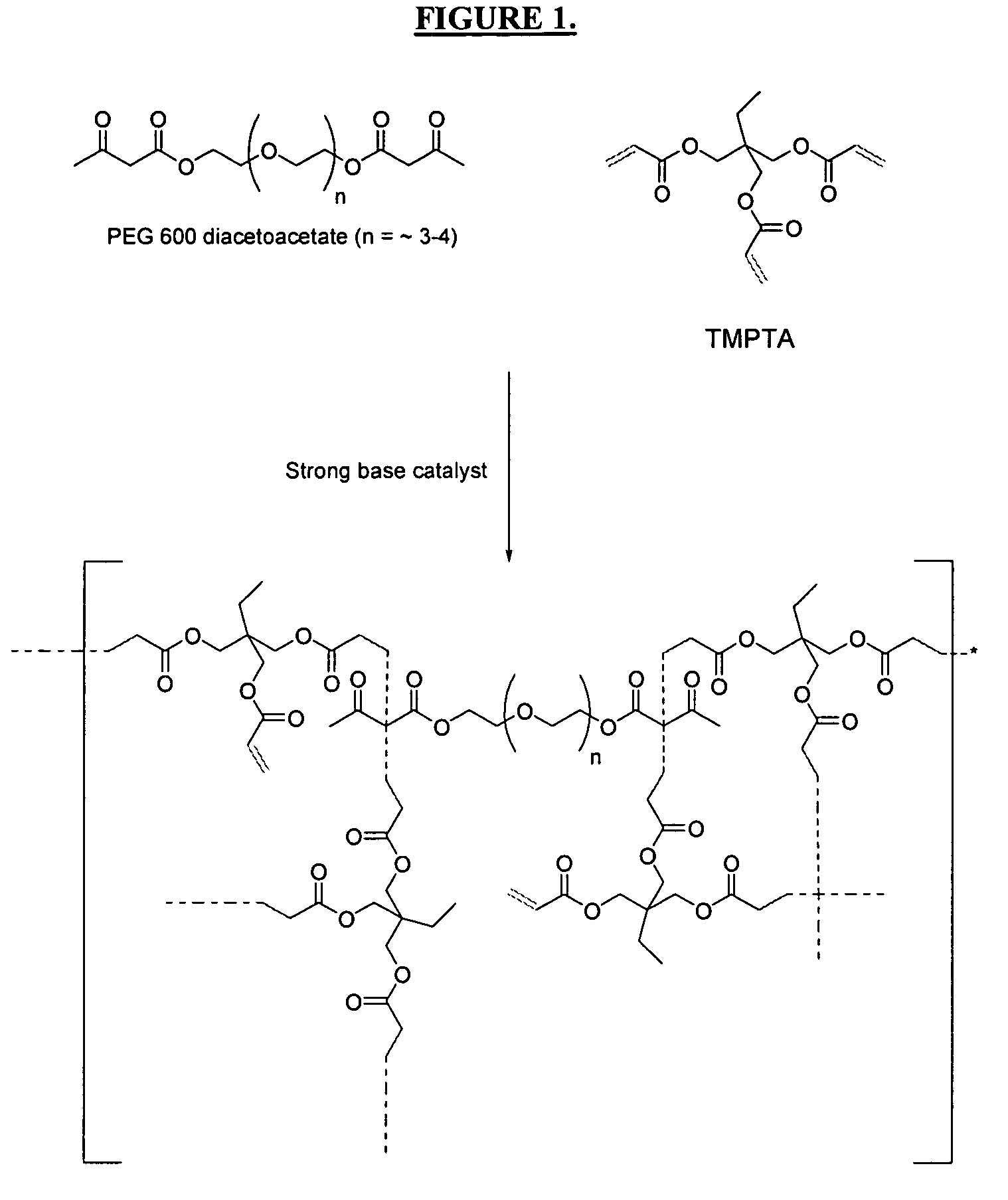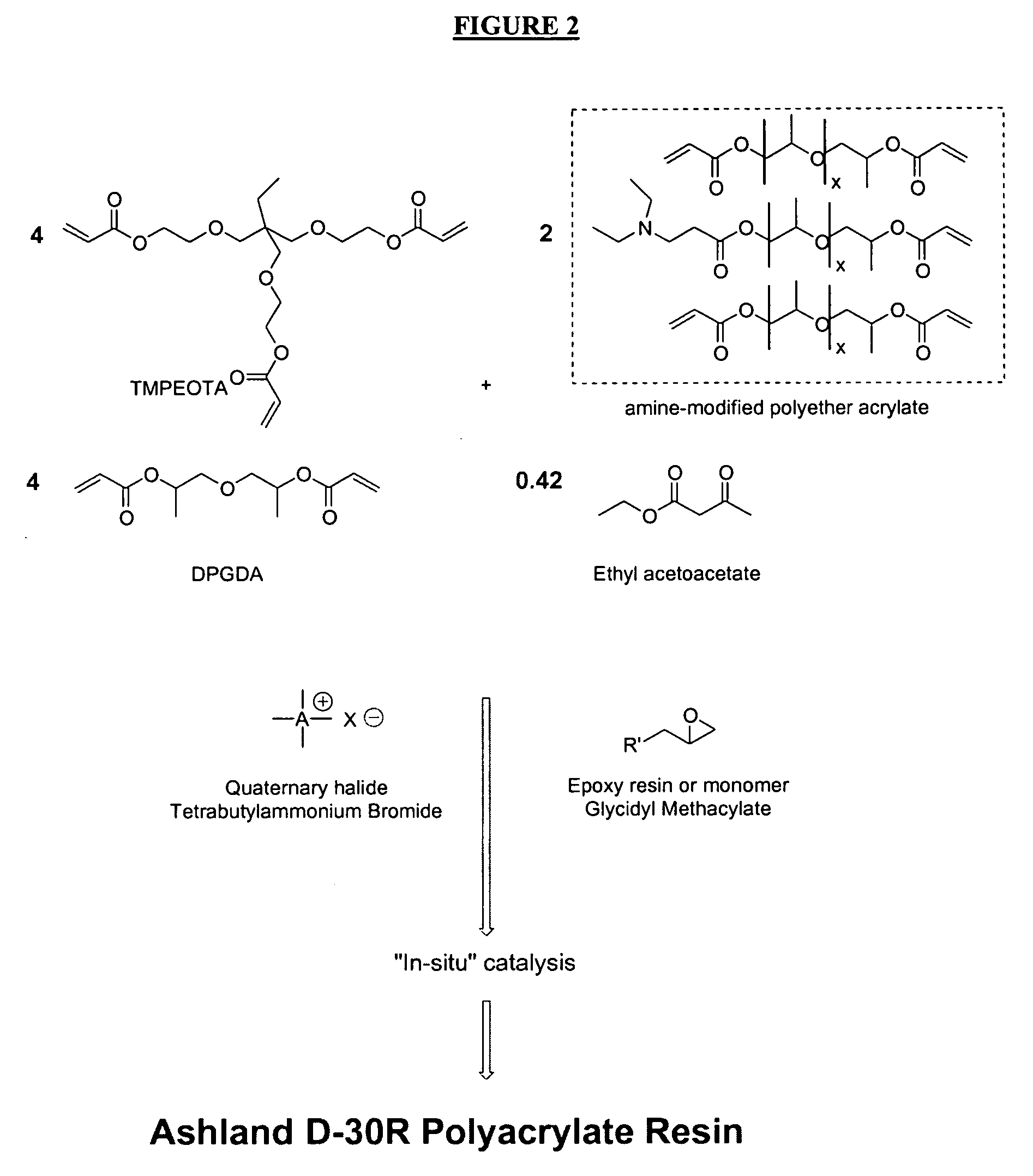Radiation-curable inks for flexographic and screen-printing applications from multifunctional acrylate oligomers
a technology of acrylate oligomers and flexographic printing, which is applied in the direction of inks, synthetic resin layered products, printing, etc., can solve the problems of limiting the applicability of white and light-colored inks being undesirable, and being toxic to traditional photo initiators (e.g., benzophenone), so as to achieve more economical effects
- Summary
- Abstract
- Description
- Claims
- Application Information
AI Technical Summary
Benefits of technology
Problems solved by technology
Method used
Image
Examples
example 1
White UV-Curing Screen-Printing Ink
[0064] Michael resin pigment-dispersion 30-w-051903-05. A white pigment was ground in a dispersion resin using a 3-roll mill. A preferred embodiment utilizes oligomer Ashland D-30R as the dispersion resin. Other Michael dispersion resins may suitably be used for inks of the present invention. A preferred Michael resin-pigment dispersion (grind formulation) for white ink comprises 45 parts by weight of Michael oligomer Ashland D-30R and 105 parts of DuPont R-706 white pigment. The resin may suitably comprise, on a weight basis, from about 10 parts to about 75 parts. The pigment may suitably comprise, on a weight basis, from about 10 parts to about 90 parts. Michael dispersion resins and pigment dispersions are disclosed in co-pending application Serial Number (number not yet assigned; Attorney Docket Number 20435 / 0151) the entire contents of which is hereby incorporated for all purposes.
[0065] Non-limiting examples of suitable whit pigments includ...
example 2
Yellow UV-Curing Screen-Printing Ink
[0078] Dispersion 30-y-051903-02. A Michael resin-pigment dispersion was formed as above for white ink. A preferred pigment, YE1400DC was ground in Ashland D-30R resin using a 3-roll mill. A preferred weight ratio is 102 parts resin and 48 parts pigment. For a yellow ink the proportion of resin may vary from about 30 parts to about 80 parts. The proportion of pigment may vary from about 20 parts to about 50 parts. As described above, Ashland D-30R is a preferred dispersion resin, but other Michael dispersion resin formulations are suitable.
[0079] Yellow ink Screen-y-052703-01. The dispersion can be reduced or diluted with suitable screen let-down resins of the present invention and additives to give the desired ink formulation. Formulation viscosity was measured and deemed acceptable as long as it matched the standard yellow ink formulation within a tolerance of 10%. The ink was screen-printed onto various substrates. Curing was affected with a ...
example 3
Red UV-Curing Screen-Printing Ink
[0082] Dispersion 30-R-051903-04. A preferred dispersion for red ink was formed by grinding a red pigment, LR-1392 with Ashland D-30R dispersion resin using a 3-roll mill. A preferred dispersion, 30-R-051903-04, comprises, on a parts by weight basis: 97.5 parts resin 6923-30, 7.5 parts TMPEOTA as a diluent monomer, and 48 parts red pigment LR-1392. Suitably, a dispersion for a red ink may comprise from about 20 parts to about 75 parts of a dispersion resin, from about 0 parts to about 10 parts of a diluent monomer, and from about 20 parts to about 50 parts of a red pigment.
[0083] The composition of the dispersion resin may vary as indicated above. Non-limiting examples of suitable diluent monomers include ethylene glycol diacrylate, propylene glycol diacrylate, diethylene glycol diacrylate, dipropylene glycol diacrylate (DPGDA), triethylene glycol diacrylate, tripropylene glycol diacrylate, tertraethylene glycol diacrylate, tetrapropylene glycol di...
PUM
| Property | Measurement | Unit |
|---|---|---|
| Fraction | aaaaa | aaaaa |
| Fraction | aaaaa | aaaaa |
| Fraction | aaaaa | aaaaa |
Abstract
Description
Claims
Application Information
 Login to View More
Login to View More - R&D
- Intellectual Property
- Life Sciences
- Materials
- Tech Scout
- Unparalleled Data Quality
- Higher Quality Content
- 60% Fewer Hallucinations
Browse by: Latest US Patents, China's latest patents, Technical Efficacy Thesaurus, Application Domain, Technology Topic, Popular Technical Reports.
© 2025 PatSnap. All rights reserved.Legal|Privacy policy|Modern Slavery Act Transparency Statement|Sitemap|About US| Contact US: help@patsnap.com


